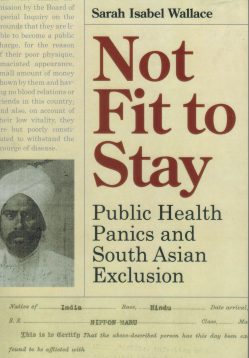Not Fit To Stay acquaints modern readers with the “hookworm strategy” of immigration law. The facts are raw. Historian Dr. Isabel Wallace of Trent University is a skillful writer. The effect is startling. If bigotry is rooted in fear and economic despair, Wallace’s research proves even the mildest society is capable of devising something akin to the Nuremberg Laws.
More than a century ago Canada feared an influx of foreigners, especially South Asians bound for work in British Columbia’s lumber trade. A 1906 financial panic didn’t help.
The result was the “Hindu disease theory” embraced by legislators, media and trade unions, that South Asia was “a hotbed of the most virulent and loathsome” infections and its people were natural carriers of the plague, cholera, venereal disease, tuberculosis and smallpox. “From a sanitary point of view I consider them worse than the lowest class of Chinamen,” as Vancouver city health inspector Robert Marrion wrote in a 1912 report.
In everyday Canadian life fear of disease was rational and commonplace. Infant mortality rates were high. Sanitation was so rudimentary Ottawa suffered a 1912 typhoid epidemic that left 94 dead. Even the mildest infection was fatal and few diseases were curable. The doctor’s role was limited to fixing broken limbs, delivering babies and signing death certificates.
Add that to pre-Holocaust racialized views of moral fitness, and the consequence is a dark chapter of Canadiana. Author Wallace documents the incredible story with appropriate indignation and incredulity, and a reporter’s eye for detail. “India’s colonial status planted discourse on the ‘Hindu’ issue at the crossroads of medicalized nativism, eugenics and colonial theory,” writes Wallace. “In this context, charges of racial and genetic inferiority often spilled over into other, more sensational areas.”
In 1903 total South Asian immigration to British Columbia numbered 10. Within four years the number rose to 2,623. The country went berserk. South Asians “had not the faintest idea of sanitation,” wrote Pacific Monthly magazine. One daily told readers: “The average Hindu looks as though something has been gnawing at his insides.”
Frederick Blair, assistant deputy minister of immigration, described Indian immigrants as “a disgrace to any human being, that they are uncleanly in their habits, are afflicted with tuberculosis, and are addicted to drink.” It was Blair who later famously wrote of Jewish refugees in 1939: “None is too many.”
Prime Minister Wilfrid Laurier’s cabinet in 1908 enacted the “continuous journey” rule, a clever bureaucratic response to B.C. protests. It stated no foreigner could land in Canada except via non-stop travel, a regulation specifically aimed at Indians who had to disembark at Hong Kong for transpacific liners. “Laurier could not have anticipated the astounding success of the continuous journey legislation,” notes Not Fit To Stay. “Only about one hundred Indians entered Canada between 1908 and 1915.”
In 1912, false rumours that a boatload of Indians were to land in Vancouver on direct passage prompted the “hookworm strategy,” a confidential plan to test passengers for parasites as justification for immediate deportation. Author Wallace documents the secret telegraph orders from the Department of Immigration. They make compelling reading.
Not Fit To Stay is an extraordinary story, meticulously documented.
By Holly Doan
Not Fit To Stay: Public Health Panics and South Asian Exclusion, by Sarah Isabel Wallace; University of British Columbia Press; 292 pages; ISBN 9780-7748-32199; $32.95









